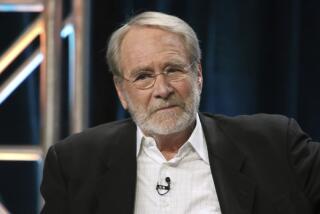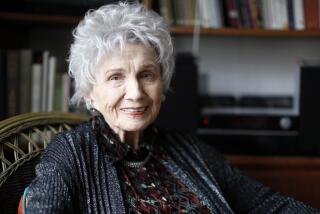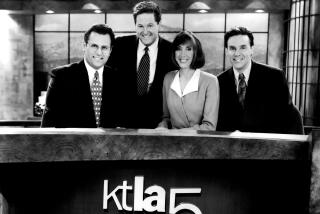The Beacon That Was Murrow
âThis . . . is London.â
Those famous words have crackled through history just as they did across the airwaves when Edward R. Murrow spoke them from a city aflame from German bombs in the early years of World War II.
Just as his voice then provided Americans with a daily link to the suffering of England, so does the mere mention of his name today connect us to the glory days of news broadcasting.
Before he became the golden icon of television news, Murrow used radio to redefine war reporting, transforming his microphone into an electronic ear and informing listeners not about soldiers but about the unsung heroism of civilians. He spoke of death and destruction, of Londoners routinely filing into underground air raid shelters to escape the blitzkrieg, of âthose black-faced men with bloodshot eyes . . . fighting fires.â
These days, of course, itâs television news--the business that Murrow literally invented while at CBS--thatâs in flames.
The point is vividly made in the two-part âAmerican Mastersâ documentary âEdward R. Murrow: This Reporter.â Itâs important and impressive. (The first part airs tonight at 10 on Channel 28, at 8 on Channel 50 and at 9 on Channel 15, with Part 2 on Aug. 6. KVCR Channel 24 is running the programs on Friday and Aug. 10.)
Murrowâs reputation as a bold, innovative and steely principled journalist embraces not only his war reporting on radio, but even more so his TV series âSee It Now,â which became the prototype of the in-depth documentary when it ran on CBS in prime time from 1952 to 1955.
âThereâs no such thing in life as a 100% hero, but if youâre half a hero, thatâs a lot of heroism, and he was more than that . . . ,â Eric Sevareid says glowingly tonight about the man who gave him his first job in broadcasting.
Murrow has been dead 25 years now, and our memories of him tend to be highly selective. Whether man and legend match, however, is not all that important.
What is important is Murrow the symbol and beacon. Even for those who canât recall quite what it was he did (this documentary should remedy that), his name evokes awe and a high standard against which all other TV journalism is ultimately measured. Murrow was the industryâs Abner Doubleday and Babe Ruth rolled into one, and no one in TV news since has even approached his hallowed status as a sort of divine spirit haunting the consciences of those who followed him.
Many are guilty consciences, youâd suspect.
In her first major documentary, Susan Steinberg opens up a time capsule for us, fusing a multitude of interviews, archival film and TV footage into a narrative seldom less than compelling. Thereâs not much about Murrow the private man here, but as Steinberg remarked by phone recently, âHe was his job, in a way.â
It was in response to the rising drum roll of war in Europe that CBS sent Murrow to London in 1937 to organize a network of correspondents there. These men would become known as âMurrowâs Boysâ--they included Sevareid, Charles Collingwood, Howard K. Smith, Bill Shadel, Richard C. Hottelet, Larry LeSueur and William Shirer--while joining their mentor on the front lines of World War II.
The radio segments selected by Steinberg are mesmerizing. For example, try closing your eyes and listening to Murrow describing one of the night bombing missions he flew over Berlin (âThe small incendiaries were going down like a fistful of white rice thrown on a piece of black velvetâ).
Actually, his postwar TV career became white rice against black velvet--from when he and producer Fred Friendly literally learned on the job while making âSee It Now,â a powerful commentary on social issues, to his contributions to âHarvest of Shame,â the landmark 1959 documentary about the plight of migrant farm workers.
It was âSee It Nowâ that perhaps first dramatically showed the power of TV by forcing the reinstatement of an Air Force man unjustly discharged on grounds that his father and sister were Communist sympathizers. And later it was Murrowâs most famous âSee It Nowâ program--an indictment of Joseph McCarthy--that accelerated the decline of the Senateâs infamous Red-hunting demagogue. Although Murrow was not the first to publicly rebuke McCarthy, this 1954 program was an extremely courageous gamble given the Communist paranoia and blacklisting of the time.
Tonightâs hour ends with Murrow nearing a collision with CBS management, in part because of controversy generated by his McCarthy program. He left CBS in 1961 to become head of the U.S. Information Agency.
Ironically, itâs not for âSee It Nowâ that Murrow is probably best remembered by the general public, but for âPerson to Person,â the breezy interview series that he hosted on CBS from 1953 to 1959. He would sit in the studio before a screen on which celebrities would give him tours of their homes. âThat was innovative,â Barbara Walters declares in the second installment. Like some of Waltersâ celebrity interviews, it was also empty.
Unfortunately, there is no consensus here on just how Murrow reconciled the harmless hokum of âPerson to Personâ with his serious intent as a journalist. Almost paradoxically, though, Steinberg does provide evidence of his disillusionment with the medium that made him as famous as the stars he interviewed. Television, he bitterly charged in a 1958 speech, is âdecadence, escapism and isolation from the realities of the world in which we live.â
Bill Moyers, who personifies the very best of TV journalism in the post-Murrow era, says here that Murrow once cynically warned him about the industryâs management hucksters: âSooner or later, theyâll get you.â
If Murrow were alive today, he might think âtheyâ got just about everyone and everything. When it was determined that TV news could be an important profit center, âtheyâ decided it was too important to leave in the hands of newspeople. Hence the TV news age of choreographers and manipulators, resulting in a business almost totally driven by technology, pictures and personalities which, in turn, drive the minds of viewers.
âEd hired people for not how they spoke, but for what they said,â Hottelet recalls tonight. People like Sevareid and Shirer, with whom Murrow later had a falling out, are evidence of that.
Now the wheel has turned, not only in the most obvious place--the expanding circus in most of local news--but also at the networks themselves, where news seems to be every bit the flaming holocaust that Murrow described from London.
At NBC, for example, Tom Brokaw frequently hits the road not for journalistic reasons--no matter what the network says--but solely to get viewers to notice him. And the best and brightest that the news division now has to offer--so it seems from the way theyâre constantly promoted on the air and given prime-time documentaries to front--are Jane Pauley and Deborah Norville.
Except for the occasional scintillating piece on â60 Minutes,â whose executive producer, Don Hewitt, once worked at Murrowâs side, the âSee It Nowâ tradition is long dead. And so is the tradition of the commercial TV documentary meant to do more than divert or entertain.
âMy first exposure to Murrow was when I was 10 or 11,â Steinberg said on the phone. âI had seen âHarvest of Shame,â and it stayed with me forever.â So she decided to end her documentary with footage of it being viewed this year by students of Edward R. Murrow High School in inner-city Brooklyn. Based on their reactions on the screen, the kids were deeply affected.
With TV news increasingly becoming the province of corporate, sales and show people, such risk-taking documentaries havenât been made in years. And the television that Murrow called âthe biggest classroom in the worldâ is now what David Halberstam tonight calls âthe greatest cash register in the world.â
This . . . is Hollywood.
More to Read
The complete guide to home viewing
Get Screen Gab for everything about the TV shows and streaming movies everyoneâs talking about.
You may occasionally receive promotional content from the Los Angeles Times.






